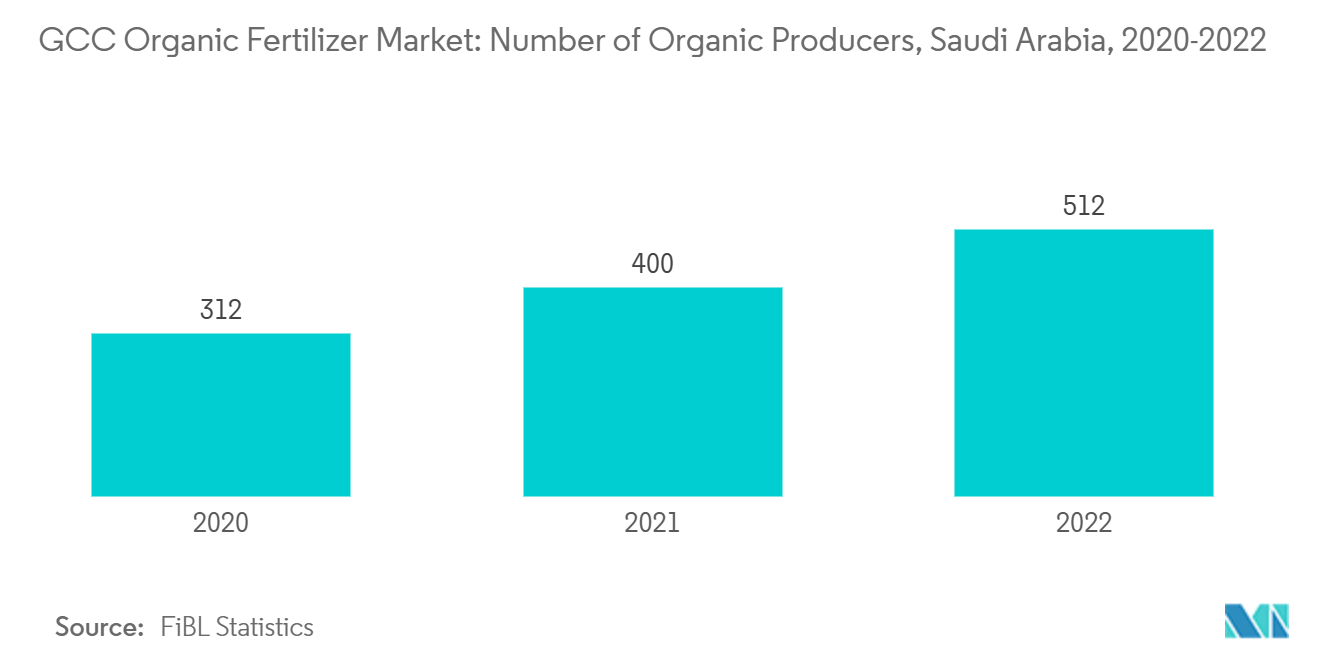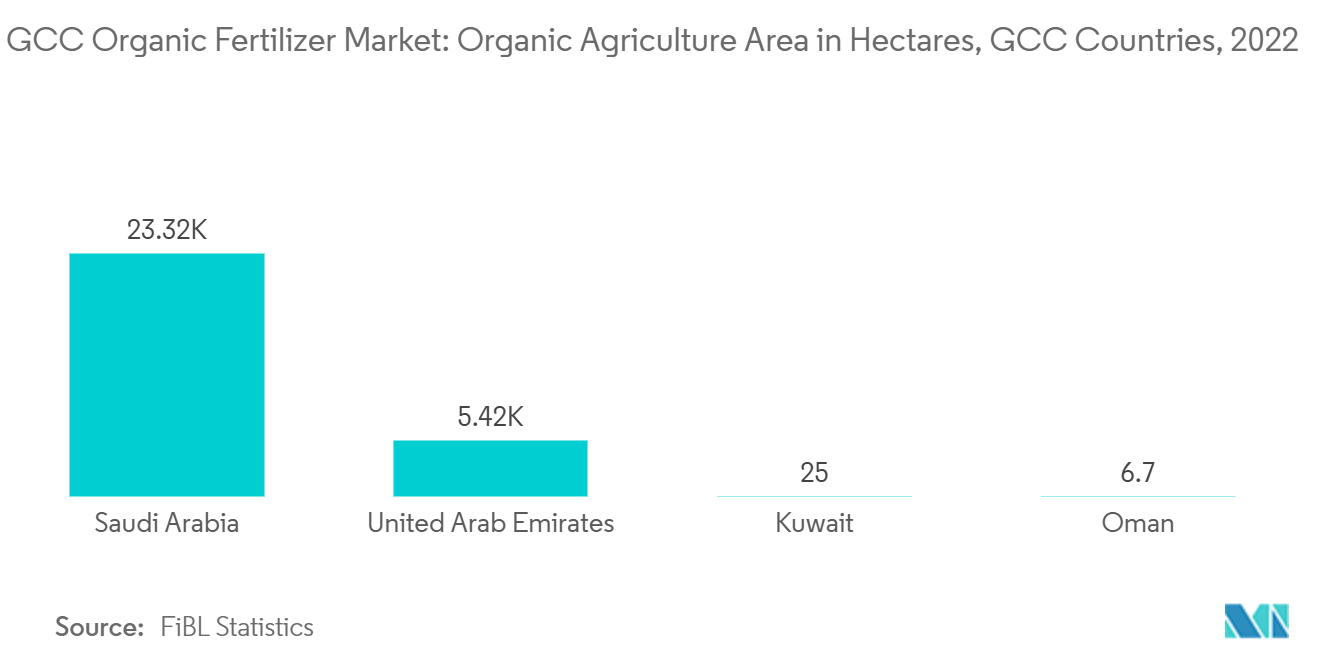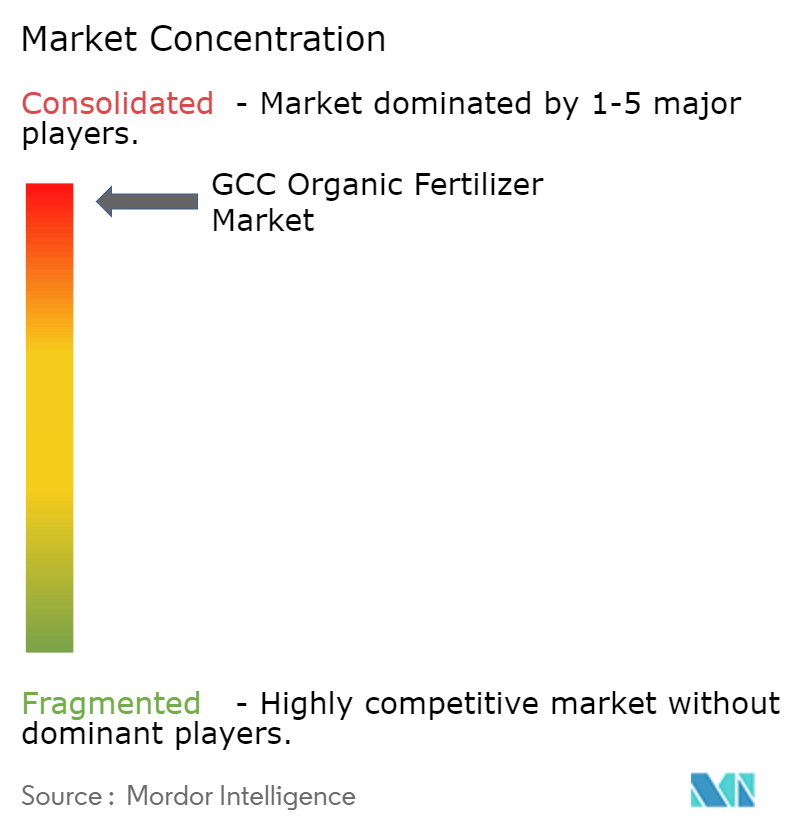
GCC Organic Fertilizer Market Analysis
The GCC Organic Fertilizer Market size is estimated at USD 10.30 million in 2025, and is expected to reach USD 22.40 million by 2030, at a CAGR of 11.74% during the forecast period (2025-2030).
The GCC organic fertilizer market is primarily driven by the increasing focus on organic farming practices and the high availability of raw materials for fertilizer production. Post-pandemic consumer awareness about healthy food has increased in the region, leading to higher organic food demand. According to the Government of Canada, organic food sales in the United Arab Emirates reached USD 47.8 million in 2023, representing a 33.9% increase from 2021.
The organic fertilizer market benefits from state-led development programs and the expansion of organic agricultural areas. FiBL statistics show that organic agricultural land in the United Arab Emirates (UAE) reached 5,419 hectares in 2022, a 29.2% increase from 4,193.2 hectares in 2019. The Ministry of Climate Change and Environment (MoCCAE) reports that 64% of UAE's organic farms are in Abu Dhabi, with 47 of the country's 74 organic farms located in the emirate as of 2023. UAE organic farms produce high-quality, nutrient-dense crops without toxic pesticide residues, using environmentally friendly production processes.
Investments in organic farming startups across major GCC countries have supported increased organic fertilizer usage. In November 2022, Biofach Saudi Arabia joined the international Biofach family as its eighth member, establishing the first international organic hub for the Middle East and North Africa (MENA) region in collaboration with the Nurnberg Messe Group. These investments in the organic farming ecosystem directly contribute to organic fertilizer market growth. The combination of increased health consciousness and expanded farming areas continues to drive the growth of organic fertilizer markets in GCC countries.
GCC Organic Fertilizer Market Trends
Increasing Focus on Organic Farming Practices
The organic products market is experiencing significant growth driven by increased consumer awareness, rising incomes, and improved farming practices that enhance organic yields. In Saudi Arabia, the organic farming sector has shown substantial expansion. According to the Saudi Organic Farming Association (SOFA), between 2016 and 2022, the country recorded a 327% increase in organic and transitional holdings (reaching 512 farms), a 142% growth in organic food retail outlets (reaching 225), and a 166% increase in organic agriculture areas. FAOSTAT data indicates that the certified organic agriculture area in Saudi Arabia expanded from 16.0 thousand hectares in 2019 to 19.1 thousand hectares in 2022. This expansion in organic farmland directly correlates with increased organic fertilizer usage.
The United Arab Emirates maintains the second-largest organic agriculture area in the region, supported by strong consumer demand and willingness to pay premium prices for organic products. FiBL statistics show that the UAE's organic share of the total agricultural area increased from 1.07% in 2019 to 1.4% in 2022. The number of organic producers also increased from 102 to 152 in 2022, indicating growing demand for organic agricultural inputs, particularly organic fertilizers, which are essential for addressing the region's poor soil conditions. GCC governments have implemented supportive measures for eco-friendly farming systems, recognizing the potential of organic agriculture.

Saudi Arabia Dominates the Market
Saudi Arabia possesses the largest arable land area in the GCC region, despite its overall limited agricultural land. The country's organic sector is experiencing notable growth, particularly in production. The number of organic producers reached 512 in 2022, according to FiBL Statistics. In the same year, organic agriculture for perennial trees (excluding palm trees) dominated the organic farming landscape, covering 11,500 hectares and representing 52% of the total organic agricultural area.
The demand for healthy and nutritious foods is increasing in Saudi Arabia, driven by urbanization and higher disposable incomes. Consumers are increasingly seeking foods with minimal chemical residues. This shift is reflected in the growth of organic retail sales, which increased by 9.7% from USD 332.0 million in 2019 to USD 341.9 million in 2022, as reported by FiBL Statistics. However, domestic organic fruit and vegetable production remains insufficient to meet local demand, resulting in high import dependence. To reduce this import reliance, efforts to enhance organic productivity are increasing, subsequently driving the demand for organic fertilizers.
Major urban centers in Saudi Arabia, including Riyadh, Dammam, Al Khobar, and Jeddah, serve as primary consumption hubs for organic products, hosting specialized organic shops and supermarkets with dedicated organic sections. The government's establishment of an annual "Organic Food Day" on November 11 demonstrates its commitment to supporting the organic sector. These developments are increasing organic production requirements and organic fertilizer demand. The expansion of organic agricultural land, combined with growing organic food demand, is anticipated to support the organic fertilizer market's growth in the coming years.

GCC Organic Fertilizer Industry Overview
The GCC organic fertilizer market exhibits a concentrated structure, with major companies controlling significant market share. The primary players include Al-Akhawain, RNZ Group, Abu Dhabi Fertilizer Industries Co. WLL, Arab Qatari Agricultural Production Company, and Emirates Bio Fertilizers Factory (EBFF). These companies focus their operations on enhancing production capabilities and strengthening distribution networks across the region.
GCC Organic Fertilizer Market Leaders
-
Al-Akhawain
-
RNZ Group
-
Abu Dhabi Fertilizer Industries Co. WLL
-
EBFF (Emirates Bio Fertilizers Factory)
-
Arab Qatari Agricultural Production Company
- *Disclaimer: Major Players sorted in no particular order
GCC Organic Fertilizer Market News
- September 2023: Uterra Middle East Agro Industries, a subsidiary of UniPax Investment Group, announced to invest USD 20 million over three years to establish the first organic fertilizer production facility in Ras Al Khaimah. The facility, situated on a 33,000 square meter plot in the Al Ghail Industrial Zone, will produce high-efficiency microbiological organic fertilizers and conduct research for agricultural solutions.
- July 2023: Desert Control (DSRT) completed the product registration process for Liquid Natural Clay with the Ministry of Climate Change and Environment (MOCCAE) in the United Arab Emirates (UAE). The MOCCAE certified Liquid Natural Clay as an organic fertilizer after a thorough evaluation process, authorizing its sale and use in the UAE market.
- March 2023: Sharjah City Municipality (SCM) has established an Organic Fertilizer Production Unit to advance its sustainability initiatives. The facility manufactures organic fertilizers for agricultural applications, with an initial daily production capacity of five metric tons.
GCC Organic Fertilizer Industry Segmentation
Organic fertilizers comprise materials derived from animal sources used to enhance plant nutrition, improve soil properties, and maintain biological activity. These fertilizers include manure, digestive tract content, compost, and digestion residues. The GCC Organic Fertilizer Market is segmented by Product Group (Organic Residues and Bio-fertilizer), Application (Grains and Cereals, Pulses and Oilseeds, Fruits and Vegetables, Commercial Crops, and Turf and Ornamental), and Geography (Saudi Arabia, Qatar, Oman, United Arab of Emirates, Bahrain, and Kuwait). The report offers market size forecasts by value in USD and volume in metric tons for the above segments.
| Product Group | Organic Residues | Farmyard Manure | |
| Crop Residues | |||
| Green Manure | |||
| Other Organic Residues | |||
| Bio-fertilizers | Rhizobium | ||
| Azotobacter | |||
| Azospirillum | |||
| Mycorrhizae | |||
| Other Bio-fertilizers | |||
| Application | Grains and Cereals | ||
| Pulses and Oilseeds | |||
| Fruits and Vegetables | |||
| Commercial Crops | |||
| Turf and Ornamentals | |||
| Geography | Saudi Arabia | ||
| United Arab Emirates | |||
| Qatar | |||
| Oman | |||
| Bahrain | |||
| Kuwait | |||
GCC Organic Fertilizer Market Research Faqs
How big is the GCC Organic Fertilizer Market?
The GCC Organic Fertilizer Market size is expected to reach USD 10.30 million in 2025 and grow at a CAGR of 11.74% to reach USD 22.40 million by 2030.
What is the current GCC Organic Fertilizer Market size?
In 2025, the GCC Organic Fertilizer Market size is expected to reach USD 10.30 million.
Who are the key players in GCC Organic Fertilizer Market?
Al-Akhawain, RNZ Group, Abu Dhabi Fertilizer Industries Co. WLL, EBFF (Emirates Bio Fertilizers Factory) and Arab Qatari Agricultural Production Company are the major companies operating in the GCC Organic Fertilizer Market.
What years does this GCC Organic Fertilizer Market cover, and what was the market size in 2024?
In 2024, the GCC Organic Fertilizer Market size was estimated at USD 9.09 million. The report covers the GCC Organic Fertilizer Market historical market size for years: 2019, 2020, 2021, 2022, 2023 and 2024. The report also forecasts the GCC Organic Fertilizer Market size for years: 2025, 2026, 2027, 2028, 2029 and 2030.

---Copy-(1).webp)


